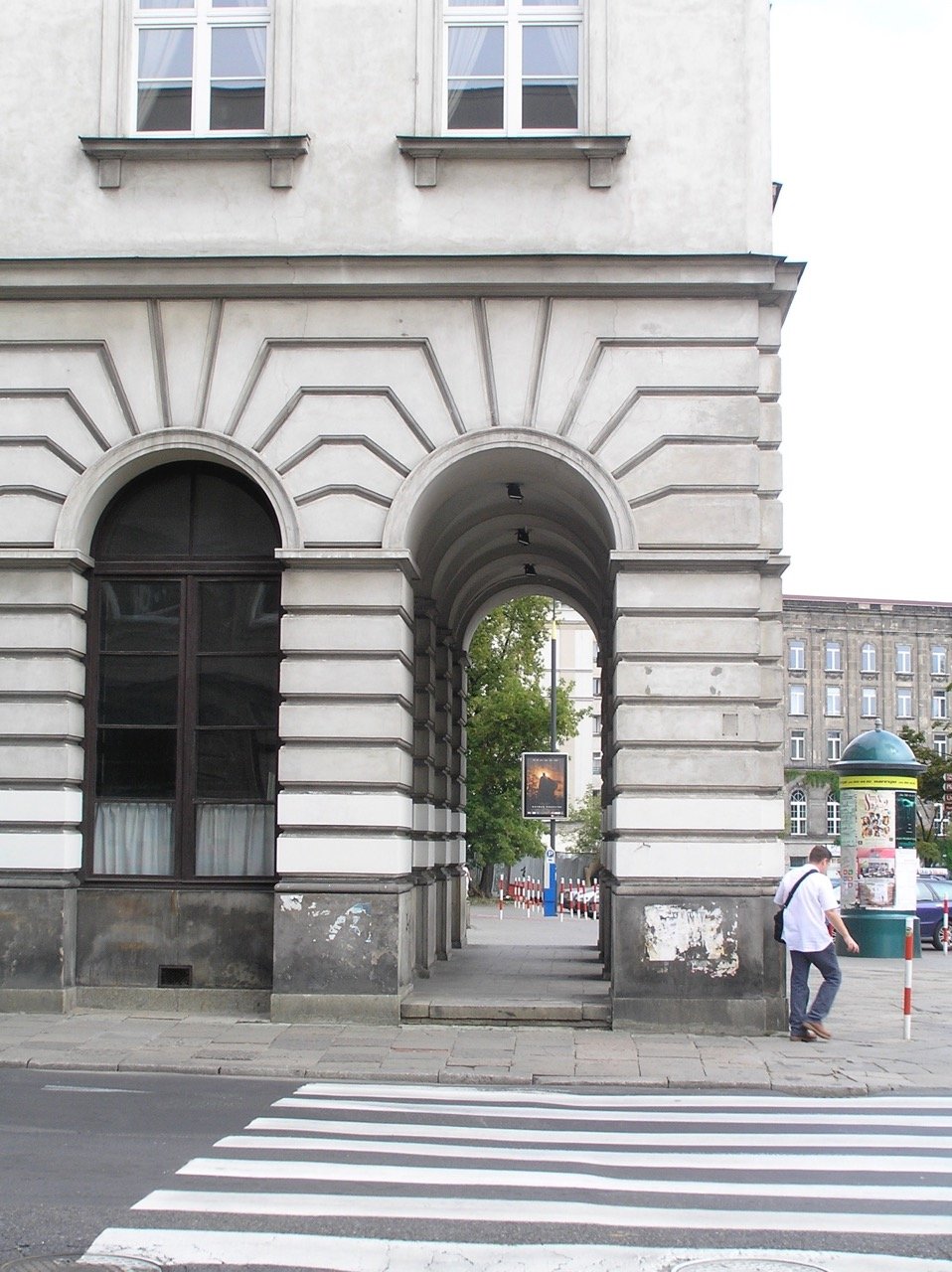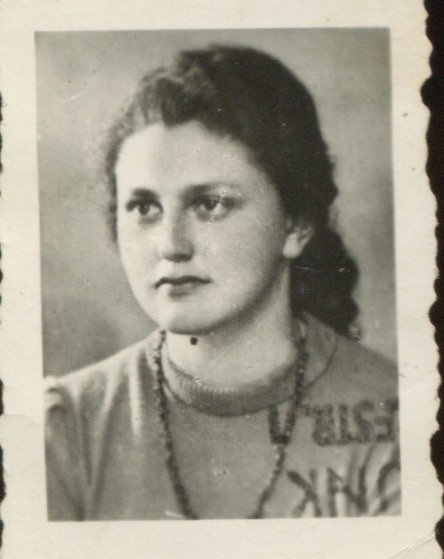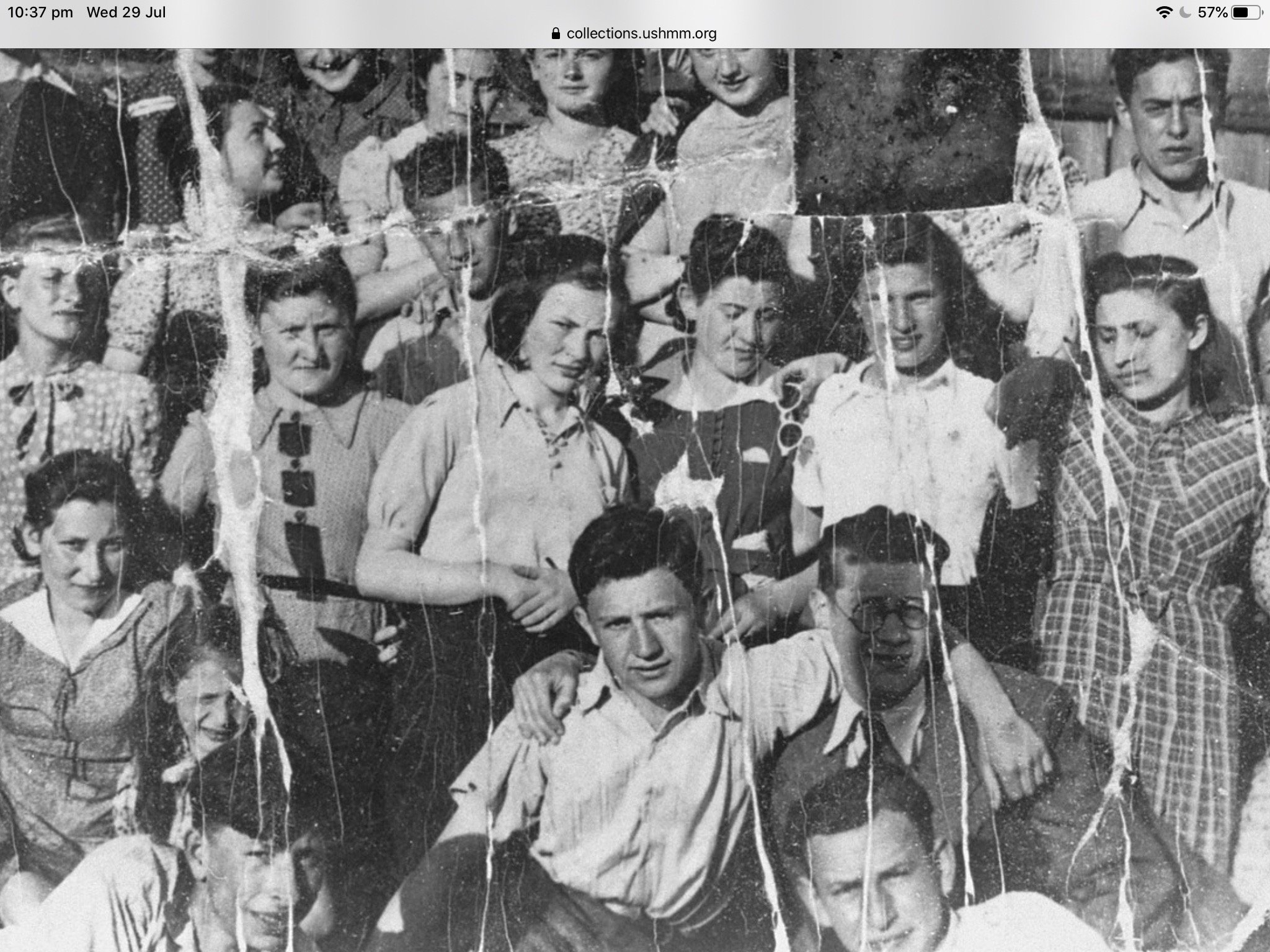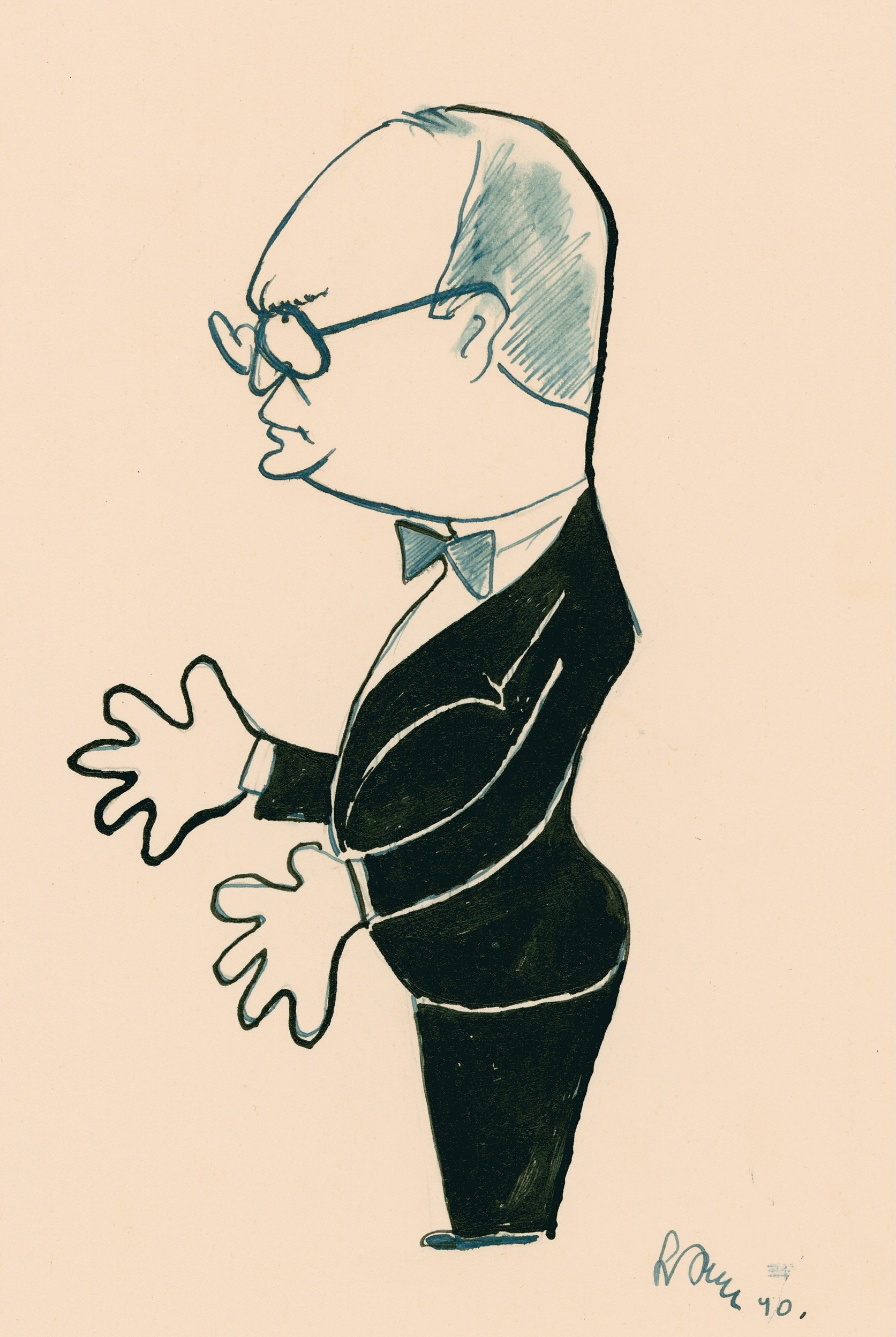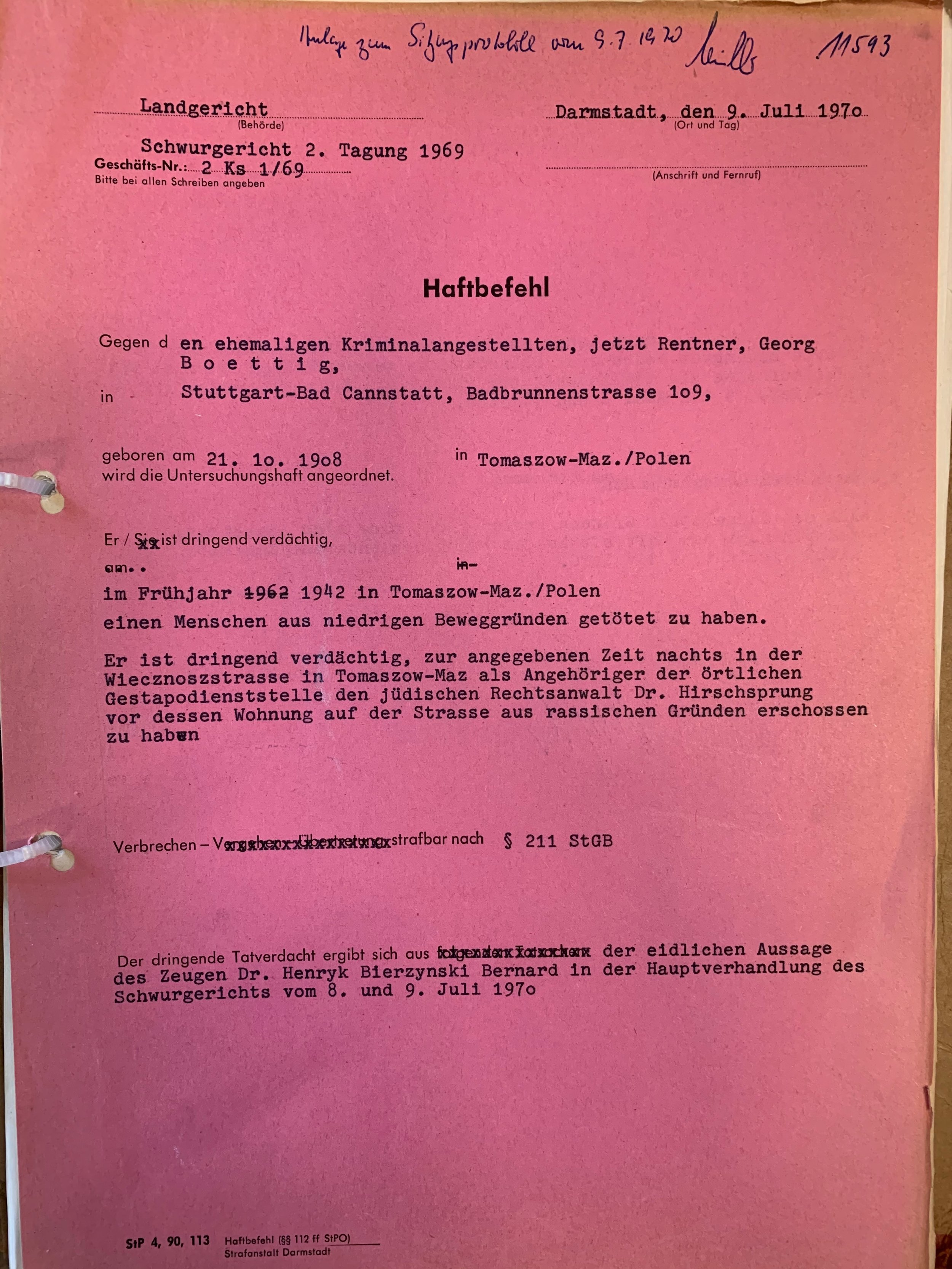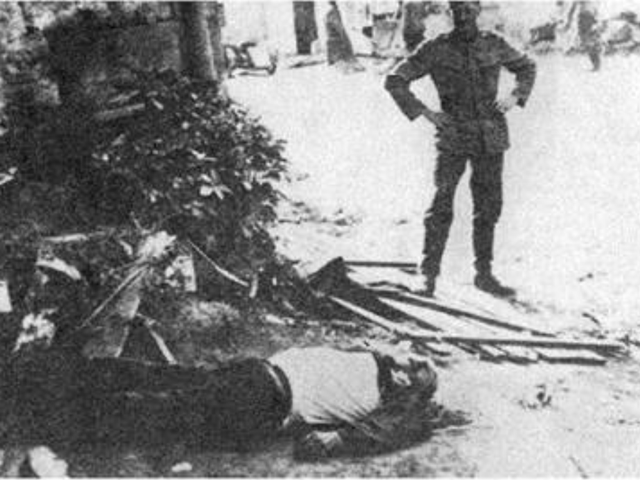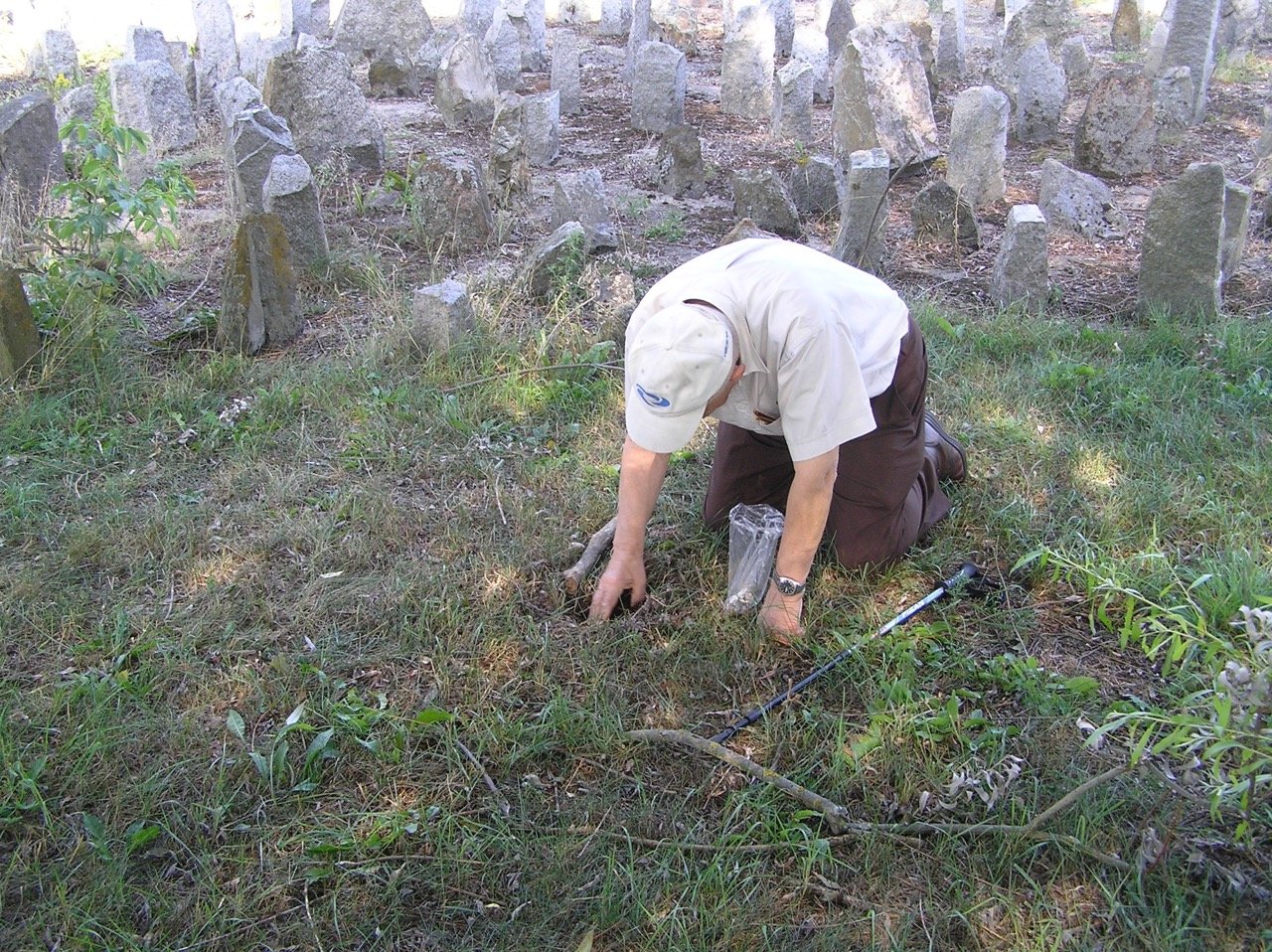The Tomaszów Ghetto
This section contains photographs and documents relevant to Henry’s war time experience in Warsaw and his life in Tomaszow during the Nazi occupation including the ghetto period.
Justyna Biernat is a Polish historian whose area of research is the Tomaszow ghetto. She has produced an online guide to the ghetto called ‘Black Silhouettes’, which can be viewed by pressing on the button.
Warsaw, September 1939
The building arches in Warsaw under which Henry and the American student sheltered during the air bombing raid.
Pawiak Prison memorial, Warsaw
The remnant of Pawiak Prison which was the main prison in Nazi occupied Warsaw in which thousands perished and is now a memorial museum.
Ghetto Gate on Jerozolimska Street
The ghetto gate is visible on the far right of the photo.
(Jerzy Pawlik Collection in Black Silhouettes)
Jews doing forced labour
A Jewish forced labour gang working on regulating the Wolborka River.
(Grzegorz Weglarski Collection in Black Silhouettes)
Certification of the Death of Bernard Bierzynski February 1942
Tomaszów Mazowiecki, 27 February 1942 Today Grojnem Ajzensztajn and Luzer Klejnberg, mourners appeared in front of the signed civil registrar and announced that on 23 February 1942 at 4 p.m Bernard Bierzyński died, married, accountant, 51, son of Natan and Berta née Warmbrun, spouses Bierzyński,residing in Tomaszów, born in Płock, leaving behind a widowed wife Toba Dwojra née Geist.
This is a translation of the death certification of Henry’s father Bernard which was found in the Tomaszow Registry Office by Justyna Biernat
Map of Tomaszów Mazowiecki showing the position of the ghetto and landmarks
The light shaded area at the bottom shows the area that was shaved off the ghetto, causing more crowding. The dark shaded triangular area shows the position of the the ‘Small Ghetto’ officially known as the Tomaszow Labour Camp after the deportation in November 1942.
Route of the march to the Tomaszow railway station for the deportation to the Treblinka extermination camp 30 October and 1 November 1942.
Henry 1942
This photo was taken in the ghetto around the time of Henry’s marriage to Halina and appears on the cover of the book.
Marriage registration document for Henry and Halina dated 21 November 1942
Below is the translation of the marriage registration of Henry and Halina in the Small Ghetto dated 21 November 1942 in the MARRIAGE RECORD BOOK which still exists in the Tomaszow City Archive. The actual document was not able to be published for 80 years until November 2023 .
In Tomaszów Mazowiecki on the twenty first of November, nineteen forty-two, at 12 pm, the witnesses Romana Margulies; married, thirty seven years old and Jakub Mendel Landsberg; a bachelor, twenty four years old, declared that in Tomaszow at 5 p.m on the thirtieth day of October, the following entered into a religious marriage: Henryk Bierzynski; a bachelor carpenter, twenty-two years old, son of Beresza and Divojry Tyli nee Geist, married name Bierzynski, resident of and born in Tomaszów Maz and Halina Aronson; seamstress, twenty two years old, daughter of Józef and Lysli aka Sofi nee Bornstzyn, married name Aronson, born in Tomaszow, Maz. and resident of Tomaszów.
The unmarried status of the newlyweds was confirmed by the above-named witnesses and by the member of the rabbinate before the religious service was given
The religious wedding was performed by a substitute rabbi of the city of Tomaszów, Icek Warszawski,a member of the rabbi's office
The newlyweds entered into a pre-wedding contract
Read, accepted and signed.
Civil registrar Rabbi
Newlyweds: Halina Aronson Henryk Bierzynski
Witnesses: Romana Margulies Jakub Mendel Landsberg
Ignacy 1942
A photo of Ignacy taken in the ghetto in 1942 and used on his forged identity card.
Tomaszow Railway Station
In front of this building a Gestapo man attempted to shoot Henry in the head but had fortunately run out of bullets.
Tomaszów Ghetto
This is where the brother of the Jewish Police Chief Wajnrab was located by Rejgrodski
Tetka Robinson, Ignacy’s girlfriend
Tetka was Ignacy’s girlfriend from the ghetto. Ignacy prepared false ID for her which also was smuggled to Henry in the Blizyn concentration camp. Tetka died of typhus in Blizyn in 1944 at the age of 18.
Tomaszów synagogue ruins
The Tomaszów synagogue on the corner of Handlowa and Wschodnia streets was destroyed by the Nazis on 16 October 1939.
Tomaszow September 1939
German police and anti-Semitic locals enjoy the humiliation of a Jewish man.
(US Holocaust memorial Museum)
Ordnungsmann Majer Erlich
Judischer Ordnungsman became known as ghetto police. Henry knew Majer Erlich whose rank is denoted by the single button on his hatband.
( Wielsaw Strzelecki Collection)
Tomaszów Ghetto 1942
Starving children and adults in the ghetto. One effect of the starvation was to dehumanise the Jewish population so to make them look different to the local Polish population.
(Hessisches Staatsarchiv, Darmstadt)
Tomaszów Ghetto 1942
The starving Jewish inhabitants were thin and emaciated.
(Hessisches Staatsarchiv, Darmstadt)
Tomaszów Ghetto 1942
A starving ghetto inhabitant with a Jewish policeman in the background.
(Hessisches Staatsarchiv, Darmstadt)
Tomaszów Ghetto 1942
Majer Erlich and ghetto inhabitants.
(Hessisches Staatsarchiv, Darmstadt)
Zenek Neumann and Yitzak Rosenblat Akiba Your Group Tomaszow ghetto 1942
A photo of the Jewish youth group Akiba in the Tomaszow ghetto, 1942. The boys in the front with their arms draped around each other are Zenek Neumark in the white shirt and Yitzak Rosenblat with the glasses. Henry was standing next to Yitzak at Auschwitz in 1944 when he was selected for the gas chamber because of his polio wasted leg. The photo was folded and carried by Judy Lachman (below the hole and behind Yitzak) throughout the war. (US Holocaust memorial Museum)
Public baths, Tcaka St Tomaszow 1940
Photo from the cover of the book shows a Jewish work detail marching past the public bathhouse in Tkacka St, on their way to work on the Wolborka riverbanks. (Wieslaw Strzelecki Collection).
Henry in the small ghetto
This is a photo taken in the small ghetto when Henry was taking photographs for fake ID cards. Note the white sheet behind him for background.
Schutzpolizei (Schupo) Tomaszow
Some Tomaszów Nazi Schutzpolizei (Schupo) with their wives. The policeman in the dark uniform in the middle is a Polish town policeman known as ‘Blue Police’. The Schupo had helmets and rifles and looked like soldiers. (Hessisches Staatsarchiv, Darmstadt).
Tomaszów Gestapo Chiefs 1939-1945
1. The criminal secretary SS-Untersturmführer Paul CHRISTOPHERSEN (1939 – ende 1940/anf.1941)
2. The criminal oversecretary and SS- Untersturmführer Erich WOTSCHE (End1940-autumn 1941)
3. The criminal commissioner und SS-Obersturmführer Karl MACHER (Autumn.1941- September 1942)
4. The criminal commissioner and SS Hauptsturmführer Herman WIESE (September 1942-September 1943)
5. The criminal commissioner and SS Hauptsturmführer RETTINGER (Sept 1943-Sept 1944)
6. The criminal commissioner and SS Obersturmführer Hermann WORTHOFF (3.9.44-Mitte Jan 1945)
Senior Nazi Police Officers in Tomaszow on Memorial Day 1943. The first on the left is the Schupo commander Grösser and the fourth from the left (tall and looking at camera) is Wiese, the Gestapo chief, who selected Henry’s mother Theodora for deportation to Treblinka on 2 November 1942. Grösser has a larger police badge on his cap band whereas Wiese has the smaller Totenkopf (skull and cross bones) badge of the SS. (Hessisches Staatsarchiv, Darmstadt)
Gestapo Chief Tomaszów 1942-1943
SS Hauptsturmführer Hermann Wiese
Memorial Day March 1943
Wiese was deputy Gestapo chief under Karl Macher but became Gestapo chief from September 1943 to September 1943. Note the Totenkopf (Skull and crossbones) badge on his cap band. He ran the selection, at the Church of St Wensceslas on Wiecznosc St on 2 November 1942, of those with ‘cover’ from the Jewish ghetto workshop, sending many, including my grandmother Theodora, to their deaths in Treblinka. (Hessisches Staatsarchiv, Darmstadt)
St Wenceslas church on Wiecznosc St
A photo of the church and its grounds in 1942, site of the selection of Jews from the Jewish workshop, who were meant to be exempt from deportation. It was from here that Theodora and others were sent to the Umschlagplatz further west along Wiecznosc St, for the march to the railway station.
( Black Sillouhettes/ Jerzy Pawlik Collection)
Schutzpolizei Chief
1941-1945
Revierhauptmann
Karl Grösser
Memorial Day March 1943
Statements by witnesses describe Grösser ordering the execution of many Jews in Tomaszow and he was responsible for the implementation of the ‘shooting order’ by his men. However he was not tried for his many crimes but instead was a witness at the Darmstadt trial, professing his anguish at issuing the ‘shooting order’. (Hessisches Staatsarchiv, Darmstadt)
Benjamin Fuchs, Volkesdeutscher Schupo in Tomaszow.
Photo from his application for German citizenship. He was a convicted child killer and mass murderer boasting at having killed more than 160 Jews in Tomaszow. Among his many crimes, he was witnessed to have picked up a baby by the neck from its crib and to have shot it point blank and on another occasion to have burned a man alive. (Hessisches Staatsarchiv, Darmstadt)
Schupo man Holz
Holz was a Schupo killer in the ghetto and was overheard bragging to Fuchs that he had killed 190 Jews in Tomaszow.
The numbers on theses photos are from their application for German citizenship.
(Hessisches Staatsarchiv, Darmstadt)
Georg Boettig in 1939
This is Beottig’s photo from his application for German citizenship after the Nazi occupation in 1939. Because he spoke Polish fluently he would start as translator at Gestapo interrogations but moved on to becoming a gestapo executioner.
Georg Boettig , newspaper picture
The Gestapo serial killer and rapist Georg Boettig terrorised the inhabitants of the ghetto.
DZIK 2017
A Polish movie called ‘Wild Boar’ was made in 2017 about the Gestapo killer Georg Boettig. The Poles hate Boettig and he and Fuchs would have been hanged for their crimes had they been extradited to Poland back in the 1960s.
Dr Jacob Hirschsprung
Dr Hirschsprung was a member of the Jewish Council who was murdered by Georg Boettig in April 1942. After taking Dr Hirschsprung from his house in the ghetto Boettig ordered him to turn and face the wall. DR Hirschsprung told Boettig, “ I am an old Austrian officer and if you going to shoot me you can shoot me in the face. I know how one should die.” Boettig said it did not matter and then shot Dr Hirschsprung in the face.
(sketch by Oren Lutenbach, US Holocaust Memorial Museum)
Site of the murder of Dr Hirschsprung
Henry is standing in front of Dr Hirschsprung’s ghetto house at the site of his murder. Dr Hirschsprung’s sons Fredek and Jerzy witnessed the murder from the balcony where the person is seated, crying out that this was murder. Boettig said to the sons, “I’ll be back”, and a couple of nights later returned and shot them both.
Fredek Hirschsprung
A childhood photo of Fredek who was about 22 when he and his brother Jerzy were murdered by Boettig.
(US Holocaust Memorial Museum)
Arrest Warrant for Georg Boettig
This is the arrest warrant for Georg Boettig , revoking his bail, issued 9 July 1970 after Henry finished giving his evidence. Henry’s evidence convicted Boettig of the murder of Dr Hirschsprung, although Henry was never aware of this fact. The main part reads:
‘He is suspected, in the spring of 1942 in Tomaszow, to have killed a person for low motives.
He is strongly suspected at the specified time in Wiecznoszstrasse in Tomaszow, at night as a member of the local Gestapo office, to have shot the Jewish lawyer Dr Hirschsprungon the street in front of his apartment for racial reasons.
Crime punishable under S211 of the Criminal Code.
The strong suspicion arises from the sworn testimony of the witness Dr Henry Bierzynski Bernard in the main hearing of the jury trial on July 8 and 9 1970.”
(Hessisches Staatsarchiv Darmstadt)
Ghetto Police and Jewish Council Office in Tomaszow
Photo taken in 1997 showing what had been the ghetto police and Jewish Council office building during the ghetto period.
Mass graves Jewish cemetery Tomaszow
Henry is walking past one of the concrete bordered mass graves in the Tomaszow Jewish cemetery in 1997.
Jewish Cemetery Tomaszów
This upturned sarcophagus was dumped by looting Nazis who were trying to steal it from the Jewish Cemetery but found it too heavy to move.
Jewish Cemetery Tomaszów
Henry and Ignacy visiting their father’s grave in 1997.
Tomaszów Ghetto 1942
A murdered Jew on the street with a German policeman standing proudly nearby.
(Courtesy of Tomaszow-Mazowiecki Yizkor Book.)
Deportation of Tomaszów Jews October 1942
(Courtesy of Tomaszow-Mazowiecki Yizkor Book.)
German police patrolling during the deportation October 1942
(Courtesy of Tomaszow-Mazowiecki Yizkor Book.)
Assembly Point Tomaszow Ghetto
This is a photo from 1997 of what had been the assembly point in the ghetto, also known as the Umschlagplatz or Sommelplatz. This is where the Jewish community was herded, formed into columns of five abreast and then marched to the railway station 5 km away for transport to the Treblinka extermination camp (31 October and 2 November 1942).
Leistenfabrik, Tomaszów Ghetto
This is the factory over looking the assembly point in the ghetto where the Jewish Community were assembled for deportation October 31, 1942. Henry’s brother Ignacy was employed here and observed the deportation from this factory.
Tomaszow showing the route of the deportation to the railway station
This shows the route from the ghetto to the station for the deportation to Treblinka October/November 1942. The ghetto, Jewish cemetery and Gestapo headquarters are also shown
Tomaszow railway station
This is where the Tomaszow Jewish community was loaded onto wagons for deportation to the Treblinka extermination camp on two day; 31 October and 2 November 1942.
Treblinka Extermination Camp Memorial
The symbolic platform at the Treblinka extermination camp memorial, where the trains from Tomaszow would have arrived on the mornings of 1 and 3 November 1942. It was a short distance to the gas chambers from here.
Treblinka Memorial
The memorial pillar which stands on the site of the Treblinka gas chambers taken from the position of the railway platform.
The path shows the short distance between the train and the gas chambers.
Treblinka Extermination Camp Memorial
This is all that was found remaining at the Treblinka site after the camp had been demolished by the Nazis in their attempt to hide their crimes. This material is the residue found in the base of the roasting pits where the bodies of the murdered Jewish community were burned.
Treblinka
Henry considered Treblinka to be the grave of his mother and collected some soil to keep as a memorial . The commemorative stones behind him commemorate the murder of Jews from the towns and villages of Poland.
The Ghost Tattoo
About The Ghost Tattoo
To the outside world, Henry Bernard was a hard-working and beloved family doctor on Sydney's Northern Beaches. Yet he was also a Holocaust survivor whose life was profoundly affected by the experiences of his past. He took extreme steps for his family's security, keeping a rifle near his bedroom and covering up his family's Jewish origin. He was obsessed with paying off debt - the German word for debt being the same as the word for 'guilt'. He kept his striped Auschwitz uniform with a picture of his mother in his wardrobe. These obsessions helped destroy his marriage and restricted any hope he had of conventional domestic happiness.
But Henry had a bigger secret and a deeper shame about what he had done during the war. He suffered privately until he began returning to Germany and Poland to confront his past and come to terms with the deaths of his parents and of Halina, the love of his life.
The Ghost Tattoo is the story of how Tony Bernard, Henry's eldest son, went on a forty-year journey with his father to solve the mystery of why Henry was the way he was, and how he finally came to understand the desperate choices Henry had made in the ghetto to try to keep himself and his family alive.
